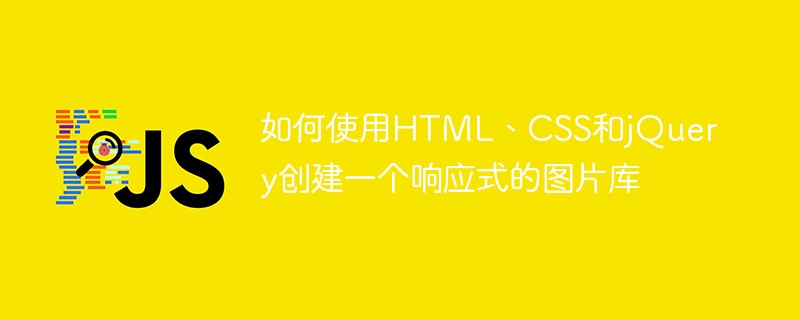How to create a responsive image gallery using HTML, CSS and jQuery

How to create a responsive image gallery using HTML, CSS and jQuery
Foreword:
With the popularity of mobile devices, responsive design has become a modern One of the important standards of web design. In this article, we’ll cover how to create a responsive image gallery using HTML, CSS, and jQuery. This image gallery allows us to display and elegantly handle images of various sizes on different devices and provide interactive features.
HTML structure:
First, we need to create a basic HTML structure for the image gallery. Below is a simple HTML template that you can modify according to your needs.
<!DOCTYPE html>
<html>
<head>
<title>响应式图片库</title>
<link rel="stylesheet" type="text/css" href="styles.css">
<script src="jquery.min.js"></script>
<script src="script.js"></script>
</head>
<body>
<div class="gallery">
<div class="image">
<img src="/static/imghw/default1.png" data-src="image1.jpg" class="lazy" alt="Image 1">
<div class="overlay">
<a href="image1.jpg" target="_blank">查看大图</a>
</div>
</div>
<!-- 添加更多图片 -->
</div>
</body>
</html>CSS styling:
Next, we need to style the image gallery using CSS. Below is a simple CSS example that you can modify to suit your needs.
.gallery {
display: flex;
flex-wrap: wrap;
}
.image {
position: relative;
margin: 10px;
flex: 1 0 calc(25% - 20px);
}
.image img {
width: 100%;
height: auto;
}
.overlay {
position: absolute;
top: 0;
bottom: 0;
left: 0;
right: 0;
background-color: rgba(0, 0, 0, 0.5);
display: flex;
align-items: center;
justify-content: center;
opacity: 0;
transition: opacity 0.3s ease;
}
.overlay a {
color: #fff;
font-size: 18px;
text-decoration: none;
padding: 10px 20px;
border: 2px solid #fff;
transition: background-color 0.3s ease;
}
.overlay:hover {
opacity: 1;
}
.overlay:hover a {
background-color: #fff;
color: #000;
}jQuery Interaction:
Finally, we use jQuery to add some interactive features to the image gallery. The following code example shows how to toggle the size of an image when clicked.
$(document).ready(function() {
$(".image").click(function() {
$(this).toggleClass("enlarged");
});
});In this example, we use jQuery's .toggleClass() function to switch the style class name "enlarged" when the image is clicked. We can add the .enlarged class to the CSS style to adjust the size of the clicked image.
.enlarged {
flex: 0 0 50%;
}In this way, when the user clicks on an image, it will be enlarged to half of its original size.
Conclusion:
By using HTML, CSS and jQuery, we can easily create a responsive image gallery. In this image gallery we can display and process images of various sizes and provide interactive features for each image. I hope this article helped you create your own responsive image gallery!
The above is the detailed content of How to create a responsive image gallery using HTML, CSS and jQuery. For more information, please follow other related articles on the PHP Chinese website!

Hot AI Tools

Undresser.AI Undress
AI-powered app for creating realistic nude photos

AI Clothes Remover
Online AI tool for removing clothes from photos.

Undress AI Tool
Undress images for free

Clothoff.io
AI clothes remover

Video Face Swap
Swap faces in any video effortlessly with our completely free AI face swap tool!

Hot Article

Hot Tools

Notepad++7.3.1
Easy-to-use and free code editor

SublimeText3 Chinese version
Chinese version, very easy to use

Zend Studio 13.0.1
Powerful PHP integrated development environment

Dreamweaver CS6
Visual web development tools

SublimeText3 Mac version
God-level code editing software (SublimeText3)

Hot Topics
 1392
1392
 52
52
 How to use bootstrap in vue
Apr 07, 2025 pm 11:33 PM
How to use bootstrap in vue
Apr 07, 2025 pm 11:33 PM
Using Bootstrap in Vue.js is divided into five steps: Install Bootstrap. Import Bootstrap in main.js. Use the Bootstrap component directly in the template. Optional: Custom style. Optional: Use plug-ins.
 The Roles of HTML, CSS, and JavaScript: Core Responsibilities
Apr 08, 2025 pm 07:05 PM
The Roles of HTML, CSS, and JavaScript: Core Responsibilities
Apr 08, 2025 pm 07:05 PM
HTML defines the web structure, CSS is responsible for style and layout, and JavaScript gives dynamic interaction. The three perform their duties in web development and jointly build a colorful website.
 How to write split lines on bootstrap
Apr 07, 2025 pm 03:12 PM
How to write split lines on bootstrap
Apr 07, 2025 pm 03:12 PM
There are two ways to create a Bootstrap split line: using the tag, which creates a horizontal split line. Use the CSS border property to create custom style split lines.
 Understanding HTML, CSS, and JavaScript: A Beginner's Guide
Apr 12, 2025 am 12:02 AM
Understanding HTML, CSS, and JavaScript: A Beginner's Guide
Apr 12, 2025 am 12:02 AM
WebdevelopmentreliesonHTML,CSS,andJavaScript:1)HTMLstructurescontent,2)CSSstylesit,and3)JavaScriptaddsinteractivity,formingthebasisofmodernwebexperiences.
 How to use bootstrap button
Apr 07, 2025 pm 03:09 PM
How to use bootstrap button
Apr 07, 2025 pm 03:09 PM
How to use the Bootstrap button? Introduce Bootstrap CSS to create button elements and add Bootstrap button class to add button text
 How to resize bootstrap
Apr 07, 2025 pm 03:18 PM
How to resize bootstrap
Apr 07, 2025 pm 03:18 PM
To adjust the size of elements in Bootstrap, you can use the dimension class, which includes: adjusting width: .col-, .w-, .mw-adjust height: .h-, .min-h-, .max-h-
 React's Role in HTML: Enhancing User Experience
Apr 09, 2025 am 12:11 AM
React's Role in HTML: Enhancing User Experience
Apr 09, 2025 am 12:11 AM
React combines JSX and HTML to improve user experience. 1) JSX embeds HTML to make development more intuitive. 2) The virtual DOM mechanism optimizes performance and reduces DOM operations. 3) Component-based management UI to improve maintainability. 4) State management and event processing enhance interactivity.
 How to set up the framework for bootstrap
Apr 07, 2025 pm 03:27 PM
How to set up the framework for bootstrap
Apr 07, 2025 pm 03:27 PM
To set up the Bootstrap framework, you need to follow these steps: 1. Reference the Bootstrap file via CDN; 2. Download and host the file on your own server; 3. Include the Bootstrap file in HTML; 4. Compile Sass/Less as needed; 5. Import a custom file (optional). Once setup is complete, you can use Bootstrap's grid systems, components, and styles to create responsive websites and applications.




